Common Welding Repair Service Issues and Just How to Address Them Successfully
Welding repairs commonly experience a series of problems that can endanger the honesty of the end product. Common troubles include poor infiltration, porosity, and misalignment, to name a few. Each problem provides special obstacles that require specific strategies for resolution. Recognizing these problems is necessary for welders aiming to enhance their end results and skills. This discussion will discover these common welding repair work issues and reliable methods to resolve them.
Inadequate Infiltration
Inadequate infiltration takes place when the weld steel falls short to completely fuse with the base material, leading to weak joints and prospective structural failures. This concern usually originates from not enough warm input, wrong electrode angle, or improper welding speed. Welders might run into inadequate penetration as a result of a miscalculation of the needed specifications for a details product density or type. Additionally, contamination on the base product's surface area can prevent effective bonding, exacerbating the trouble. To address poor infiltration, welders ought to assure proper settings on their tools and maintain a clean work surface. Normal evaluation of welds is recommended to determine any shortages early, permitting prompt corrections and the avoidance of compromised structural stability in bonded settings up.
Porosity
Porosity is a common flaw in welded joints that shows up as small gas bubbles caught within the weld steel. This defect can jeopardize the honesty of the weld, resulting in minimized toughness and potential failure under tension. Belgrade Fabrication. Porosity commonly arises from contamination, moisture, or incorrect welding methods, which allow gases to leave right into the liquified weld swimming pool. To deal with porosity, welders ought to guarantee appropriate surface area prep work, maintain a clean working environment, and utilize appropriate welding criteria. In addition, picking the appropriate filler product and shielding gas can mitigate gas entrapment. Regular evaluation and testing of welds can assist determine porosity early, assuring prompt restorative activities are taken, therefore preserving the top quality and reliability of the bonded framework
Misalignment
Misalignment in welding can develop from numerous aspects, including improper configuration and thermal development. Understanding the origin is vital for efficient resolution. Numerous adjustment strategies are available to realign components and assure architectural stability.
Reasons of Misalignment
Welding misalignment commonly comes from a selection of underlying concerns that can endanger architectural honesty. One main reason is inappropriate fit-up of parts prior to welding, which can lead to spaces and uneven surface areas. Variations in thermal development during the welding procedure can additionally lead to distortion, specifically if the materials being signed up with have different coefficients of expansion. In addition, insufficient fixturing and clamping might fail to hold elements securely in position, bring about movement throughout welding. Badly kept tools, consisting of welding makers and tools, might introduce disparities in the weld grain, more adding to imbalance. Operator mistake, stemming from inadequate training or experience, can additionally play a considerable duty in creating misaligned welds.

Correction Techniques Readily Available
Attending to misalignment successfully calls for a combination of rehabilitative methods customized to the certain concerns available. One typical approach is using components or jigs to hold parts in the appropriate setting throughout welding, ensuring constant placement. In addition, pre-heating the materials can help in reducing distortion and enhance fit-up. For considerable misalignment, mechanical adjustment strategies, such as making use of hydraulic jacks or clamps, can be utilized to fix the placement before welding. Post-weld warm treatment might likewise be required to soothe stress and anxieties caused by misalignment. Careful evaluation and change throughout the setup stage can stop misalignment concerns from becoming considerable troubles, advertising a smoother welding procedure and enhancing overall structural integrity.
Distortion
Distortion is an usual obstacle in welding that can develop from different factors, including irregular home heating and air conditioning. Understanding the causes of distortion is essential for carrying out effective prevention techniques. Resolving this concern not just boosts architectural stability but likewise improves the overall high quality of the weld.
Reasons of Distortion
When based on the extreme warm of welding, products commonly go through modifications that can lead to distortion. This sensation mostly occurs from thermal development and contraction throughout the welding procedure. As the weld location heats up, the product broadens; upon cooling, it acquires, which can create internal stress and anxieties. In addition, irregular heating throughout a work surface can exacerbate these tensions, leading to bending or flexing. The sort of material likewise plays a significant role; steels with varying thermal conductivity and coefficients of expansion might respond differently, causing unforeseeable distortions. Inadequate joint design and insufficient fixturing can add to misalignment during welding, boosting the probability of distortion. Understanding these causes is important for reliable welding repair work and prevention techniques.
Prevention Techniques
Reliable avoidance techniques for distortion throughout welding focus on managing warmth input and making certain correct joint layout. Keeping a constant heat input assists to lanthanated tungsten lessen thermal development and contraction, which can cause distortion. Using strategies such as pre-heating the work surface can additionally reduce the temperature gradient, advertising uniform heating. In addition, choosing ideal joint styles, such as T-joints or lap joints, can improve security and lower anxiety concentrations. Applying correct fixturing to protect the work surfaces in position even more aids in preserving positioning throughout the welding process. Staggered welding series can disperse warmth extra equally, protecting against local distortion. By using these approaches, welders can substantially reduce the probability of distortion and boost the general high quality of their welds.
Fracturing
Splitting is a typical concern run into in welding repair work, commonly arising from different variables such as incorrect cooling prices, product option, or insufficient joint preparation. The incident of cracks can greatly jeopardize the integrity of the weld, bring about prospective failures throughout procedure. To address this problem, welders should initially examine the origin, guaranteeing that materials work and appropriately picked for the particular application. Additionally, controlling the cooling rate throughout the welding process is important; fast air conditioning can induce stress and anxiety and result in breaking. Proper joint design and prep work additionally add to reducing the risk. Implementing these strategies can enhance weld top quality and resilience, inevitably decreasing the likelihood of splitting in finished weldments.

Incomplete Fusion
A significant concern in welding repairs is incomplete combination, which occurs when the weld steel does not effectively bond with the base material or previous weld passes - Montana Mobile Welding and Repair. This defect can bring about weaknesses in the joint, potentially compromising the stability of the bonded structure. Factors adding to incomplete blend consist of inadequate heat input, incorrect welding method, and contamination of the surfaces being signed up with. To resolve this problem successfully, welders must ensure appropriate pre-weld cleansing and surface prep work, as well as readjust their welding specifications to accomplish appropriate penetration and combination. Regular examination during the welding procedure can also help recognize insufficient combination early, permitting for prompt corrective actions to boost the total top quality of the weld
Overheating
While welding repair right here work can boost structural honesty, overheating offers a substantial difficulty that can bring about material deterioration. Extreme warmth during welding can modify the mechanical residential or commercial properties of steels, causing reduced toughness, boosted brittleness, and warping. This sensation is specifically critical in high-stress applications where architectural integrity is critical. Determining overheating can entail visual evaluations for discoloration or distortion, in addition to monitoring temperature during the welding procedure. To alleviate the threats related to getting too hot, welders need to employ suitable techniques, such as regulating heat input, readjusting traveling rate, and making use of appropriate filler products. Furthermore, implementing pre- and post-weld heat treatments can assist recover material buildings and enhance the general high quality of the fixing, making certain long-lasting performance and safety.
Frequently Asked Inquiries
What Are the Usual Indications of a Welding Problem?

Just How Can I Examine My Welds for Quality?
To evaluate welds for quality, one can utilize visual evaluations, ultrasonic testing, and radiographic techniques. Each technique assures structural honesty, identifies issues, and verifies adherence to defined criteria, eventually enhancing the integrity of the welded joints.
What Safety and security Precautions Should I Take While Welding?
When welding, one need to prioritize security by wearing suitable individual safety tools, ensuring proper ventilation, protecting flammable materials away, maintaining a clean office, and recognizing environments to avoid injuries and mishaps.
Can I Repair a Weld Without Redoing the Entire Joint?
Fixing a weld without redesigning the whole joint is feasible, depending upon the damages (Welding). Strategies such as grinding, adding filler material, or making use of a welding process can efficiently attend to certain imperfections while maintaining the bordering framework
What Devices Are Crucial for Reliable Welding Fixes?
Necessary tools for efficient welding repair services consist of a welding device, cord brush, grinder, safety equipment, clamps, and filler products. Each tool plays an essential duty in making certain quality and safety during the fixing procedure. Porosity typically emerges from contamination, dampness, or improper welding techniques, which enable gases to escape into the liquified weld swimming pool. Inadequately maintained tools, consisting of welding makers and devices, may introduce variances in the weld bead, more contributing to imbalance. When subjected to the extreme warmth of welding, products often go through changes that can lead to distortion. Fracturing is a common concern experienced in welding repair work, frequently resulting from various factors such as incorrect air conditioning prices, product selection, or insufficient joint prep work. A substantial issue in welding repair services is insufficient blend, which happens when the weld steel does not effectively bond with the base next page material or previous weld passes.